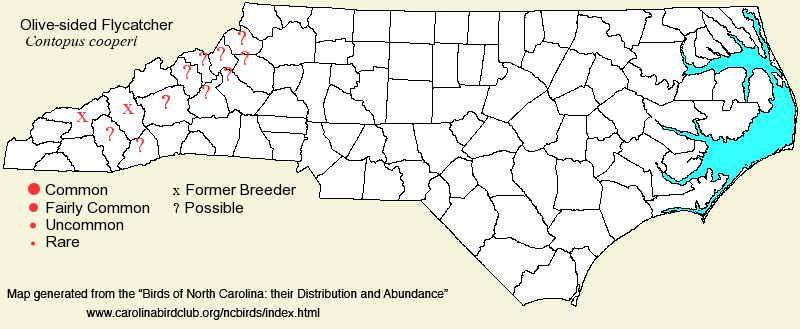 |  |
|
Olive-sided Flycatcher - Contopus cooperi TYRANNIDAE Members: | Search Common: Search Scientific: |
|
|
|||||||
| General Comments | The Olive-sided Flycatcher has a very wide breeding range, in the boreal forests from Alaska to Labrador, south through the Rockies and Sierra Nevadas, and sparingly southward into the Appalachians. Sadly, this species has been in decline throughout the range, for uncertain reasons. It apparently bred in the NC mountains into the 1950's or 1960's, at least in Great Smoky Mountains NP, though details are sketchy and there is no certain confirmation. There have been scattered summer records since then in the mountains, possibly of birds looking for mates. At any rate, this species has never been 100% confirmed as a breeder, and with each passing year (global warming), it is less likely that birds will nest in the state. Nonetheless, breeding habitat remains abundant in the mountains. In the remainder of the state, it passes through in migration in very small numbers, mainly in the Piedmont. Thankfully, it is almost always found perched on a high and exposed bare branch, easily seen by a birder on the ground. From these perches, the birds make long sallies and often return to that same perch. Its breeding habitat in the state is/was openings and margins of spruce-fir forests, such as near burns or diseased areas, with some dead trees. In migration, it tends to avoid conifers, and it favors mature hardwood forests or edges, where there are tall trees with bare branches. | ||||||
| Breeding Status | Former Probable Breeder | ||||||
| NC BRC List | Definitive | ||||||
| State Status | W | ||||||
| U.S. Status | |||||||
| State Rank | SU | ||||||
| Global Rank | G4 | ||||||
| Coastal Plain | Transient. Very rare in fall, and casual/accidental in spring; only about 17 records. Two of the only three spring records are in May along the northern coast; one is near the Fall Line at Cape Fear Shiner Park (Harnett) in 2024. In fall, scattered across the region, mainly mid-Aug to early Oct. One at Glenburnie Quarry (Craven) on 15 Oct 2015 was a late record. Peak count: one. | ||||||
| Piedmont | Transient. Rare in both spring and fall, across the region. Primarily from early May to late May, with a few records in Jun and early Jul; and from mid-Aug to early Oct. No records from Nov through Apr. Peak count: 4 ("3 young birds seen begging for food", with the other presumed to be an adult), North Wilkesboro, 12 Sep 1968; 2, Chapel Hill, 3 May 1992. However, 12 Sep is a very late date for nesting, and North Wilkesboro is in the Piedmont. Thus, this report should not be considered as probable breeding. | ||||||
| Mountains | Transient and former summer resident, with current "breeding" status undetermined. Many scattered records in the breeding season, and likely nested formerly along the NC-TN line in Great Smoky Mountains NP; "uncommon summer resident in the high-altitude spruce-fir forests" (Stupka 1963). Most intriguing was a singing male seemingly on territory in northeastern Buncombe, along the border with Yancey, from 9-17 Jun 2022; no female or other breeding evidence was reported. Otherwise, it is a rare spring and fall migrant over the region; primarily early May to early Jun, and mid-Aug to late Sep, with a few records from mid-late Apr to late Oct. Peak count: 2, Black Mountain (Buncombe), 2 Oct 2004. | ||||||
| Finding Tips |
This bird is too rare to expect to see one. Your best bet is to drive roads in the mountains, especially over 3,500 feet, during May, and carefully scan any bare branches you see, especially high ones (over 50 feet above ground). A handful of records have been made using this strategy, such as along the Heintooga Road in the Great Smoky Mountains NP. Inland birds are seen at a few parks each spring and fall. Always remember to check bare branches near the tops of hardwood trees, as the birds seldom are seen perched anywhere else. * | ||||||
| Attribution | LeGrand[2025-07-28], LeGrand[2025-02-03], LeGrand[2024-08-05] | ||||||
| NC Map Map depicts all counties with a report (transient or resident) for the species. | Click on county for list of all known species. |
| NC Breeding Season Map Map depicts assumed breeding season abundance for the species. |  |